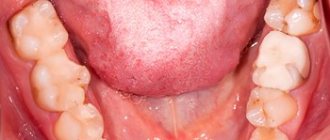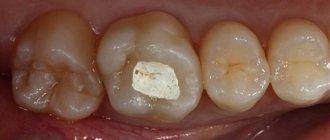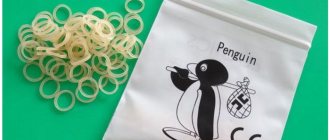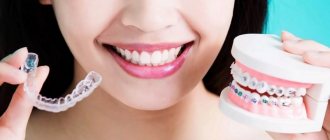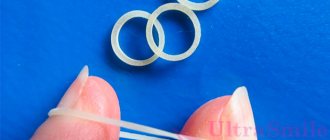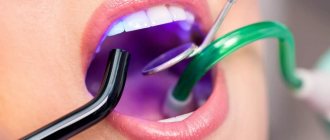When is a child's dental nerve removed?
The main indication for removing a nerve in a child’s tooth is pulpitis.
The disease is characterized by inflammation of the pulp, in the tissues of which there are vessels and the nerve itself. Pulpitis is accompanied by severe pain, deterioration of general condition and weakened immunity. There are risks of inflammation spreading and complications developing. Nerve inflammation is a complication of deep caries. Microbes that penetrate the dentin gradually infect the pulp, resulting in pulpitis. If treatment is not carried out in a timely manner, the pathological process begins to progress, gradually spreading to the soft tissues, and then to the jaw bone.
Removal of the nerve of baby teeth is not carried out only if the child has already begun the process of changing teeth, and a permanent tooth is growing in the coming months. An x-ray is taken to determine the prognosis. For such indications, tooth extraction is performed, since there is no risk of bite displacement.
Duration of pain syndrome
Normally, after all dental procedures, the affected tooth should not bother you. As a result of the action of the paste, the nerve dies spontaneously. It stops sending signals to the brain, and the patient himself does not feel discomfort.
Sometimes a tooth starts to hurt again for a number of reasons:
- insufficient dose of arsenic or incorrect placement of paste;
- exceeding the dosage, as a result, the onset of soft tissue necrosis;
- complex pathological process;
- allergy to the components of the paste, which is accompanied by inflammation of the mucous membrane;
- high pain threshold;
- inflammatory reaction as a response to the toxic properties of arsenic;
- drug-induced periodontitis, manifested by fever and swelling.
The pain syndrome is usually aching in nature and intensifies with pressure. Tissue necrosis lasts no more than 2-3 days. Throughout this period, the tooth may hurt. If the discomfort cannot be tolerated, it is better to consult a doctor again.
When pain after medical procedures is normal
Many patients complain of severe pain after arsenic ingestion. In the absence of medical errors, this situation can be perceived as the norm. For example, with a high pain threshold. A person simply feels the process of tissue necrosis. In this case, it is important to monitor the dynamics. Over time, the pain should subside.
The duration of use of a temporary filling with arsenic is determined by the doctor. This period is always individual and depends on several factors: the condition of the teeth and microflora, the age of the patient. As a rule, no more than 5 days pass from application of the filling to its complete removal.
When pain after medical procedures is not the norm
Severe pain cannot be tolerated. This can lead to complete loss of a tooth. It is important to constantly monitor your well-being and be able to distinguish increased sensitivity from increasing, severe pain. Doctors identify the following alarming symptoms, in which you should seek medical help immediately.
In some cases, severe pain after dental procedures indicates an insufficient dosage of arsenic. The tooth continues to bother the patient, but the nerve does not die. However, such cases are extremely rare in practice.
We can come to the conclusion that pain after putting arsenic paste into a tooth is most often a signal of pathology or disorder. It is necessary to seek medical help immediately to accurately determine the cause of this condition. On the other hand, patients must be able to independently distinguish severe pain from unpleasant or uncomfortable sensations, which are considered normal in the first 3 days after the procedure. With proper therapy, they gradually subside.
What symptoms should you contact your dentist for?
Ideally, you should visit the dental clinic with your child every six months, and if signs of caries appear, treatment should begin immediately. But more often, parents turn to specialists when their child begins to suffer from severe toothache.
You should make an appointment with a dentist if your child exhibits the following symptoms:
- feeling of bursting and dull toothache;
- reduction of pain after eating hot food or during sleep;
- tooth sensitivity when eating;
- purulent odor from the mouth even after brushing your teeth;
- extensive carious cavity;
- other damage to the dental crown.
Pulpitis is characterized by rapid progression of the inflammatory process. If the nerve is removed at the initial stage, there will be no complications. In advanced cases, the pathological process can develop into a cystic or granulomatous form, or the infection begins to spread to the jaw bones or sinus tissue.
How harmful is it?
Arsenic is a poison, but in dentistry it is used in very small doses and is not dangerous when used correctly. The instructions for use state that the maximum dose should not exceed 0.0008 g.
The main tasks are to take precautions, inject the drug into the tooth pulp without introducing dirt, and monitor the health and the body’s reaction to the substance.
If arsenic begins to kill healthy tissue, then even after its removal some of the paste will remain, later leading to inflammation.
Why does pain occur?
Immediately after applying the substance, the tooth may hurt for several hours in a row.
Immediately after applying the substance, the tooth may hurt for several hours in a row. This is a normal situation in which there is no need to panic. After time, the pain will subside.
In the first days after the substance is installed, there is a possibility of pain. This is a consequence of the effect of arsenic on the tooth root.
The paste usually contains anesthetic substances - lidocaine, novocaine or dicaine. They guarantee pain reduction, making the process of nerve death painless.
But in special cases, unpleasant sensations may persist (due to increased sensitivity of the body or incorrect installation). If the pain persists, then perhaps the doctor prescribed an insufficient dose of anesthetic.
As soon as the nerve is killed, the pain will disappear. After this period, you can go to the doctor and carry out further treatment.
However, if pain persists after this, this indicates that the necrosis process has affected the jaw bones. Consult your doctor - the drug may need to be removed immediately.
Why did the temperature rise?
The doctor, having established arsenic, in addition to pain relief, advises the patient to purchase antipyretic drugs in case the body temperature rises during the period of root necrosis.
If the doctor made a mistake during installation and installed the filling too tightly, then drug-induced inflammation may occur, accompanied by:
- The appearance of edema.
- Temperature increase.
- Increasing pain.
This leads to the formation of an abscess on the gums. The affected area should be immediately shown to a specialist.
Why does a temporary filling fall out?
While the temporary filling is in place, change your diet and eat exclusively soft foods that will not lead to cracks or breaks.
The temporary filling must be intact during the period of nerve killing.
It ensures the tightness of the internal cavity of the tooth, preventing the drug from entering the oral cavity.
Otherwise, there is a risk of the aggressive substance coming into contact with healthy tissues, or food getting into the affected area.
To do this, the doctor advises, while the temporary filling is in place, to change your diet and eat exclusively soft foods that will not lead to the appearance of cracks or breaks.
But the hardness of the filling also depends on the materials used - if high-quality materials are used, the patient is allowed to eat on both sides, practically without limiting himself in food.
However, the temporary filling should not be too dense either - otherwise it will put strong pressure on the tooth pulp.
This, by the way, is another factor in the appearance of pain. In this case, if there is pain, the patient will not be able to remove it on his own and will have to go to the dentist.
Methods for depulpation of the dental nerve
The method of removing a nerve in a baby tooth is determined by the stage of pulpitis and the degree of tissue damage. Treatment may involve partial or complete depulpation. The decision on the method of performing the procedure is made by the attending physician.
At the Martinka Children's Dental Clinic, dental nerve removal for children is performed using two methods.
- Chemical. The dentist puts a drug into the tooth cavity that “kills” the nerve. The drug does not affect healthy tissue. While the paste is in effect, a temporary filling is placed on the tooth. After 1–5 days, the filling is removed, and the pulp and nerve are removed. The method is only available for complete depulpation.
- Instrumental. The child is given anesthesia to relieve pain. The tooth is opened and the pulp is removed completely or partially using special instruments. At the end of the procedure, a medicinal paste with anti-inflammatory and antiseptic action is placed into the tooth cavity. A temporary filling is installed. After a few days, the drug is removed and a permanent filling is installed instead of a temporary filling.
If the inflammatory process has started, then upon completion of treatment, the dentist may prescribe a course of antibacterial drugs. Taking painkillers is permissible only as prescribed by a doctor.
Why is arsenic used?
Even at the beginning of the twentieth century, doctors actively used arsenic for syphilis and anemia. Today it is often used in dental practice. A paste based on arsenic anhydride is applied to the tooth to completely kill the nerve.
The most common problem with which patients go to the dentist is toothache. It indicates the transition of the carious process to soft tissues. The destruction of those areas that contain nerve endings begins. This is the final stage of the carious process. If upon contact the dentist discovers an inflamed and bleeding pulp, its contents are immediately removed.
Several manipulation options are possible:
- The doctor removes the soft pulp tissue without first devitalizing the nerve endings. The procedure itself is performed using local anesthesia. However, people do not always resort to her help.
- Most often, the dentist opens the pulp and puts an arsenic-based paste into it. It devitalizes soft tissues. The procedure is completely harmless to health, since the concentration of arsenic is low. The nerve dies within a few days, then at a follow-up appointment the doctor removes it.
Usually the dentist warns the patient about possible side effects. He also talks about alarming symptoms. If they appear, you should seek medical help. Sometimes it happens that a temporary filling falls out if all post-therapeutic recommendations are followed. For example, when the material has not yet dried, and the patient decides to drink some water. In this case, you must first check to see if there is any paste left in the mouth.
Then you need to thoroughly rinse your mouth and cover the canal with a sterile swab and consult a dentist. Such actions do not eliminate the urgent need for medical care. Ignoring a filling that falls out can lead to negative consequences. In emergency cases, such patients are usually admitted urgently and without a queue.
Does it hurt or not?
The sensitivity of teeth is provided by a nerve that is located in the pulp tissue. For this reason, both the pathology itself and the process of its elimination presuppose the presence of pain.
Dentistry has ample opportunities for painless treatment of pulpitis. Anesthesia is used for this. Modern drugs are safe and do not pose a risk to the child’s health.
Methods of dental anesthesia.
- Local anesthesia. An anesthetic is injected into the soft tissues, eliminating any sensation for a certain period of time. To ensure that the child does not feel the injection, topical anesthesia is additionally used.
- Sedation. The method is also called “medicated sleep.” Pain relief is achieved by placing the child under a mild general anesthesia. To administer the anesthetic, intravenous and inhalation methods are used. The duration of anesthesia is from 10 minutes to 2 hours.
When treating young children under 5 years of age, dentists give preference to medicated sleep. It is difficult for a child to simultaneously cope with fear and maintain a calm position, which can complicate the procedure and cause tissue injury. Sedation allows you to eliminate psychological trauma and any painful sensations, as well as make the dentist’s work easier and speed up the treatment process.
Contraindications
Since arsenic is an aggressive and toxic substance, in some cases it cannot be used.
Contraindications for use include:
- Due to the toxicity of arsenic, it cannot be used in some cases.
Allergy to arsenic components (trioxy, lidocaine, ephedrine).
- Treatment of infants (up to 1.5). Their body, due to its instability, cannot cope with the negative effects of arsenic, even if tiny fractions of the drug are used.
- Killing of nerves in children with unformed or absorbable tooth roots.
- If the doctor, after installing arsenic, cannot completely clean and expand the canals in the tooth. It depends on the individual structure of the roots of each person. There are cases when the patient has a strong curvature of the canals, or part of it is closed or blocked by tartar (denticle).
- When the roots were subject to perforation (an artificial through hole was made), or when the roots were separated.
- With increased intraocular pressure , which signals the risk of developing glaucoma.
- If the patient suffers from diseases of the urinary and reproductive systems (even worse - with kidney or prostate diseases).
Consequences of nerve removal
In the first 1–2 days after treatment, the tooth may hurt, but the intensity of the pain gradually decreases. To alleviate the condition, you can take analgesics recommended by a specialist. There are no other consequences of nerve removal.
Since pulpitis is most often caused by caries, during the treatment process the dentist removes the affected crown tissue. Restoring the integrity of the tooth is performed after removing the temporary filling. For correction, a filling material that does not contain toxic substances is used. In some cases, when the area of the carious cavity is too large and there is a risk of the filling falling out, it is recommended to install prostheses (stump or artificial crown.
Many parents mistakenly believe that depulpation implies the absence of a nerve in a permanent tooth. However, this is not at all true. Temporary and permanent teeth have separate systems and tissues that are not interconnected.
Martinka Children's and Adolescent Dentistry treats pulpitis by removing the nerve. Timely and correctly performed removal of the nerve of a baby tooth has no consequences. The integrity of the tooth is restored, and its functionality is preserved.
Composition of arsenic filling
A dosage of arsenic from 5 to 50 mg is considered dangerous. It is strictly forbidden to use the substance in its pure form. It is included in the medicinal paste.
In addition to arsenic, its components are the following:
- various anesthetics (Novocaine, Lidocaine or Dicaine);
- antiseptic solutions (for example, Timol);
- tannin;
- fillers that give the composition a paste-like consistency.
After placing a special arsenic-based paste into the cavity, the pulp cells die. As a result, its blood supply is completely suspended, and the transmission of nerve impulses stops. This is the first stage of treatment for pulpitis, in which the pain syndrome should be relieved. It is impossible to cure this pathology without removing the nerve. However, in order to perform all the manipulations as painlessly as possible, you must first kill the nerve process.
After applying the paste, the dentist covers the affected area of the tooth with a temporary filling. Its main function is to protect the composition from possible loss. As a rule, after fixation, the tooth may still hurt for 2-3 days. If it aches a lot, you can rinse it with a weak solution of soda.
Complications when keeping the product in the tooth for a long time
Since arsenic is toxic, leaving the medicine for more than seven days leads to the following consequences:
- The occurrence of inflammation in the soft tissues of the tooth.
- Necrosis of the incisive bone.
- Pulp swelling.
- Spread of necrosis to adjacent teeth.
The patient must follow the advice of a specialist and obtain the drug in a timely manner. The slightest delay ends in intoxication of the entire body.
What happens if you hold it for too long?
Arsenic is practically not used for depulpation in pregnant women and children
Since the substance is aggressive and toxic, with prolonged use it will not only deaden the nerve, but also begin to kill healthy tissue - teeth, roots, gums.
The same applies to neighboring areas. If you keep arsenic for too long, there is a risk of:
- Poisoning of the body, disruption of the digestive system and liver.
- Periodontal inflammation.
- Gum death.
